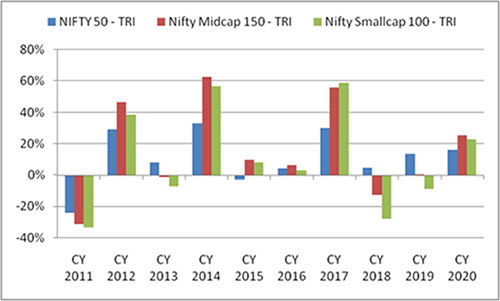Multi-cap Fund v/s Flexi-cap Fund: Which is a Better Fit for Your Portfolio?
Listen to Multi-cap Fund v/s Flexi-cap Fund: Which is a Better Fit for Your Portfolio?
00:00
00:00
Different market cap segments have distinct benefits as well as risk profiles. An investment in large-cap stocks offers the advantage of steady growth at lower volatility. On the other hand, the mid-cap and small-cap stocks have the ability to outpace the large-cap stocks, but they are highly volatile.
A combination of different market caps in your portfolio enables optimal wealth creation in the long run. It also helps in minimising the market risk. As a result, you earn optimal risk-adjusted returns. Certain equity mutual fund categories such as multi-cap funds and flexi-cap funds invest across the market capitalisation range to offer investors the benefit of diversification.
While both funds have the mandate to invest across market caps, there are few factors that distinguish the two. Read on to know how the two categories differ in their portfolio characteristics as well as risk-reward parameters...
Graph 1: Performance across market caps differs every year

Data as of December 31, 2020
(Source: ACE MF)
In September last year SEBI changed the definition of multi-cap funds. Multi-cap funds now have the mandate to invest at least 75% of its total assets in equities, with at least 25% exposure each in large-cap, mid-cap, and small-cap stocks.
This was done to ensure that multi-cap funds hold a diversified portfolio across large-cap, mid-cap, and small-cap companies, be true to its label, and to distinguish it clearly from other scheme categories.
Earlier, in the absence of any restriction on the market cap allocation, most multi-cap funds held a predominantly large-cap biased portfolio along with strategic allocation to mid-cap and small-cap stocks. Therefore, to avoid reshuffling the portfolio to align with the new norms, most existing multi-cap funds have switched to the flexi-cap category.
So the Flexi-cap fund is a recently launched category under equity mutual funds that have the mandate to invest minimum 65% of its assets in equities without any restriction on market cap allocation. This provides fund managers with more leeway in building the portfolio.
Under the new category and name, these erstwhile multi-cap funds will continue to follow their current investment strategy because it offers complete flexibility for the fund while investing across market cap segments. Hence, the recategorization will not have any significant impact on the way mutual fund houses manage these schemes.
Not just with fund houses, the category has gained traction with investors as well. With active participation from investors the category witnessed net inflows of Rs 11,508 crore in July 2021. ICICI Pru Flexi Cap new fund offer collected Rs 9,808 crore during the month, contributing the most to the inflows in the category.

Image source: our-team - www.freepik.com
Does this mean flexi-cap funds have an advantage over multi-cap funds?
Multi-cap funds have to maintain the minimum exposure of 25% in each market cap, regardless of the market conditions. During bearish market phases, stocks in the mid-cap and small-cap segment may face liquidity constraints and high volatility. Therefore, multi-cap funds can witness a higher drawdown compared to flexi-cap funds. However, the presence of large caps in the portfolio can offset some of the volatility.
Most flexi-cap funds currently hold a predominantly large-cap biased portfolio with around 60%-75% allocation in the segment. Additionally, the category can invest the balance allocation in the mid-cap and small-cap segments.
Going ahead, one can expect flexi-cap funds' portfolio/s to be skewed towards large-caps. The category can even reduce the exposure to smaller caps to zero if the situation so requires. Such flexibility coupled with the higher large-cap allocation can aid in stabilizing the portfolio during bearish phases.
On the other hand, during bull market phases, multi-cap funds can outpace flexi-cap funds. During the broad-based market rally, mid-cap and small-cap stocks generally soar higher than large-cap stocks. Consequentially, multi-cap funds can benefit from higher allocation in the segment and reward investors with higher gains.
Table: Multi-cap and Flexi-cap fund performance in the last 6 months
| Category |
Absolute (%) |
| 6 months |
| Category average: Flexi Cap Fund |
14.95 |
| NIFTY 500 - TRI |
13.63 |
| Category average: Multi Cap Fund |
18.75 |
| NIFTY 500 Multicap 50:25:25 TRI |
16.71 |
Data as on August 24, 2021
(Source: ACE MF)
That said, over the long term, both categories can reward investors with superior gains since they have the freedom to select from a large universe of stocks. This gives fund managers greater scope to identify alpha-generating opportunities across the market cap spectrum. However, selecting a worthy multi-cap or flexi-cap scheme that aligns with your financial needs is crucial.
Which is a better fit for your portfolio?
The decision on whether to invest in a multi-cap fund or a flexi-cap fund should depend on your financial goals, risk profile, and investment horizon. Avoid investing in either category based on its short term performance.
Flexi-cap funds are suitable for investors looking to invest in a large-cap oriented fund along with tactical allocation to mid-cap and small-cap stocks. Invest in the category with a horizon of around 5 years. However, if you are willing to take higher risk for better returns, you can consider investing in multi-cap funds. Do note that if you are planning to invest in multi-cap funds, you must have a longer investment horizon of at least 5-7 years due to the higher mid-cap and small-cap components.
Whichever category you choose, ensure that you invest in worthy schemes after evaluating its performance on various qualitative and quantitative parameters. Prefer the SIP mode of investment to mitigate the impact of volatility and benefit from the power of compounding.
PS: If you are looking for quality mutual fund schemes (including Equity-linked Saving Schemes) to add to your investment portfolio, I suggest you subscribe to PersonalFN's premium research service, FundSelect. PersonalFN's FundSelect service provides insightful and practical guidance on which mutual fund schemes to Buy, Hold, and Sell.
Currently, with the subscription to FundSelect, you could also get Free Bonus access to PersonalFN's Debt Fund recommendation service DebtSelect.
If you are serious about investing in a rewarding mutual fund scheme, subscribe now!
Warm Regards,
Divya Grover
Research Analyst
Join Now: PersonalFN is now on Telegram. Join FREE Today to get ‘Daily Wealth Letter’ and Exclusive Updates on Mutual Funds